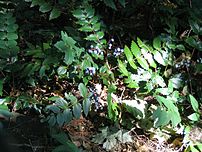[amazon_link asins=’1556590997,B0062F546W,B0753X2F3Z,B077772PRZ,B06XQVZZF9,B01FKTYAAG,B0785GV8CR,B077WZ66JR,B075PB3NG7′ template=’ProductCarousel’ store=’finmeacur-20′ marketplace=’US’ link_id=’61f07ceb-f2f1-11e7-9d31-efa0b4dabe4c’]
Botanical Name : Amelanchier confusa
Family: Rosaceae
Genus: Amelanchier
Species:A. canadensis
Kingdom:Plantae
Order: Rosales
Synonyms: Amelanchier canadensis auct., Amelanchier grandiflora auct.
Common Names: Service berry, Shadblow, Shadbush, Sugarplum, Shad
Habitat:Amelanchier confusa is native to Europe – S. Sweden. This species is only known from plants naturalised in Sweden, its origin is uncertain.
Description:
Amelanchier confusa is a deciduous woody perennial Shrub growing to 3 m (9ft) by 3 m (9ft). It has smooth, ovate leaves which are irregularly serrated. The autumn colour is inconspicuous.
It is not frost tender. It is in flower in May, and the seeds ripen from Jun to July. The flowers are hermaphrodite (have both male and female organs) and are pollinated by Bees.The plant is self-fertile.
Cultivation:
Prefers a rich loamy soil in a sunny position or semi-shade but thrives in any soil that is not too dry or water-logged[11]. Grows well in heavy clay soils. Prefers an acid or neutral soil. All members of this genus have edible fruits and, whilst this is dry and uninteresting in some species, in many others it is sweet and juicy. Many of the species have potential for use in the garden as edible ornamentals. The main draw-back to this genus is that birds adore the fruit and will often completely strip a tree before it is fully ripe. A suckering plant, the suckers are formed very close to the original stem so the plant forms a gradually expanding clump. Plants growing at Hilliers Arboretum in Hampshire were 4 metres tall in early April 1999, they were suckering quite freely in a tight clump and flowering very freely. This species is closely related to A. laevis. Hybridizes freely with other members of this genus. Grafting onto seedlings of A. lamarckii or Sorbus aucuparia is sometimes practised in order to avoid the potential problem of hybridizing.
Propagation:
Seed – it is best harvested ‘green’, when the seed is fully formed but before the seed coat has hardened, and then sown immediately in pots outdoors or in a cold frame. If stored seed is obtained early enough in the autumn, it can be given 4 weeks warm stratification before being left out in the winter and it should then germinate in the spring. Otherwise seed can be very slow to germinate, perhaps taking 18 months or more. When large enough to handle, prick the seedlings out into individual pots and grow them on in a sheltered outdoor position, planting them out once they are 20cm or more tall. If there is sufficient seed it is best to sow it thinly in an outdoor seedbed. Grow the seedlings on for two years in the seedbed before planting them out into their permanent positions during the winter. Layering in spring – takes 18 months. Division of suckers in late winter. The suckers need to have been growing for 2 years before you dig them up, otherwise they will not have formed roots. They can be planted out straight into their permanent positions if required.
Edible Uses:
The fruit is edible both raw and cooked. It is 7 – 9mm in diameter. The fruit is rich in iron and copper.
Medicinal Uses:
Not yet known.
Disclaimer : The information presented herein is intended for educational purposes only. Individual results may vary, and before using any supplement, it is always advisable to consult with your own health care provider.
Resources:
http://www.pfaf.org/user/Plant.aspx?LatinName=Amelanchier+confusa
https://en.wikipedia.org/wiki/Amelanchier_canadensis
https://www.greenplantswap.co.uk/plants/1105
http://www.henriettes-herb.com/plants/amelanchier/confusa.html
Related articles
- Grouping species by the combination of morpho-chemical traits (desertification.wordpress.com)
- Host Plant Use by the Invasive Halyomorpha halys (Stål) on Woody Ornamental Trees and Shrubs (journals.plos.org)
- Parasitic Plant Species In Japan Do Not Use Photosynthesis, Feeds On Fungi (techtimes.com)
- Volunteers help sow native seeds on Nebraska prairie (journalstar.com)
- Raise awareness for invasive species Feb. 21-27 (farmanddairy.com)
- Invasive arrowhead weed discovered in Tauranga (radionz.co.nz)
- Organic Chemical Free Gardening (theearthfriendlyfamily.com)
- Volunteers help sow native seeds on Nebraska prairie (columbustelegram.com)
- Getting to the root: wildflower research provides clues on climate change (cbc.ca)
- DONG Energy Invests In New UK Bio Plant (cleantechnica.com)
![Reblog this post [with Zemanta]](https://i0.wp.com/img.zemanta.com/reblog_e.png?w=580)





















